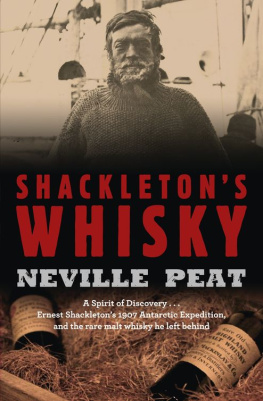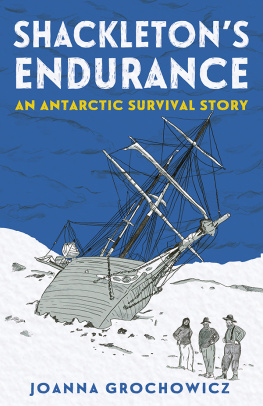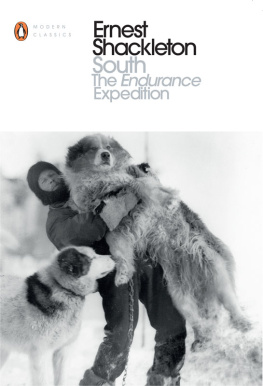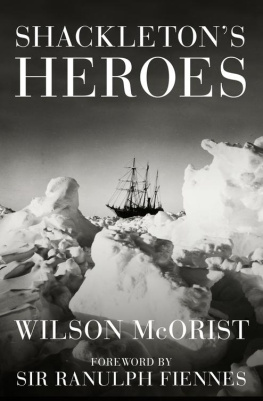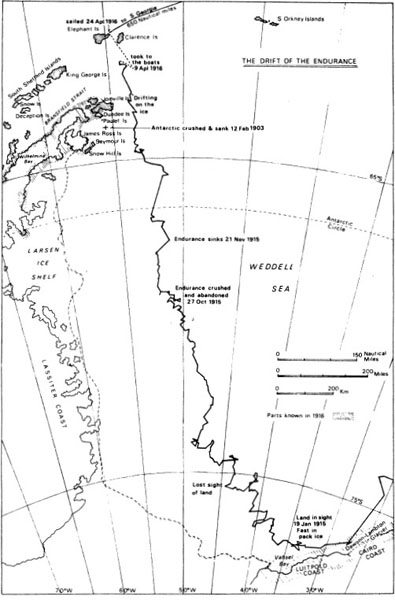
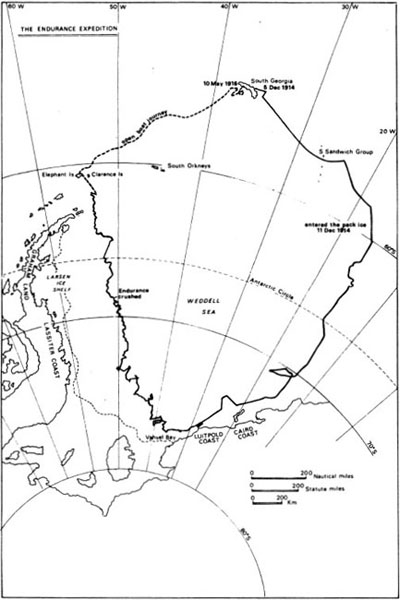

ENDURANCE
Shackletons
Incredible Voyage
ALFRED LANSING

A Member of the Perseus Books Group
New York
Published in 2007 by Basic Books,
A Member of the Perseus Books Group
Copyright 1959 by Alfred Lansing
First published by Carroll & Graf in 1986
Published by arrangement with Mrs. Alfred Lansing
All rights reserved. No part of this book may be reproduced in any manner whatsoever without written permission except in the case of brief quotations embodied in critical articles and reviews. For information, address the Perseus Books Group, 387 Park Avenue South, New York, NY 100168810.
Basic Books are available at special discounts for bulk purchases in the United States by corporations, institutions, and other organizations.
For more information, please contact the Special Markets Department at the Perseus Books Group, 2300 Chestnut Street, Suite 200, Philadelphia, PA 19103, or call (800) 2551514, ext. 5000, or e-mail special.markets@perseusbooks.com .
Library of Congress Cataloging-in-Publication Data is available.
ISBN 978-0-7867-0621-1
54 53 52 51 50 49 48
Contents
The story that follows is true.
Every effort has been made to portray the events exactly as they occurred, and to record as accurately as possible the reactions of the men who lived them.
For this purpose, a wealth of material has been generously made available to me, most notably the painstakingly detailed diaries of virtually every expedition member who kept one. It is amazing how thorough these diaries are, considering the conditions under which they were kept. In fact, the diaries contain much more information than could be included in this book.
These logs are a wonderfully strange assortment of documents, smudged with the smoke of blubber oil, wrinkled from being waterlogged and then dried out. Some were written in bookkeepers ledgers in appropriately large handwriting. Others were kept in very small notebooks in tiny script. In all cases, however, the exact language, spelling, and punctuation have been preserved just as they were originally written.
In addition to making these diaries available to me, almost all the surviving members of the expedition submitted to long hours, even days, of interviewing with a courtesy and cooperativeness for which my grateful appreciation is hardly an adequate repayment. The same patient willingness marked the numerous letters in which these men replied to the many questions which arose.
Thus most of the survivors of this astounding adventure worked with me, graciously and with a remarkable degree of objectivity, to re-create in the pages that follow as true a picture of the events as we could collectively produce. I am extremely proud of my association with them.
However, these men bear no responsibility whatever for what follows. If any inaccuracies or misinterpretations have crept into this story, they are my own and should in no way be attributed to the men who took part in this expedition.
The names of those who helped to make this book possible appear at the back of the book.
A.L.
Sir Ernest Shackleton | leader |
Frank Wild | second-in-command |
Frank Worsley | captain |
Lionel Greenstreet | first officer |
Hubert T. Hudson | navigator |
Thomas Crean | second officer |
Alfred Cheetham | third officer |
Louis Rickinson | first engineer |
A. J. Kerr | second engineer |
Dr. Alexander H. Macklin | surgeon |
Dr. James A. McIlroy | surgeon |
James M. Wordie | geologist |
Leonard D. A. Hussey | meteorologist |
Reginald W. James | physicist |
Robert S. Clark | biologist |
James Francis (Frank) Hurley | official photographer |
George E. Marston | official artist |
Thomas H. Orde-Lees | motor expert (later store-keeper) |
Harry McNeish | carpenter |
Charles J. Green | cook |
Walter How | able seaman |
William Bakewell | able seaman |
Timothy McCarthy | able seaman |
Thomas McLeod | able seaman |
John Vincent | able seaman |
Ernest Holness | fireman |
William Stevenson | fireman |
Perce Blackboro | stowaway (later steward) |
The order to abandon ship was given at 5 P.M. For most of the men, however, no order was needed because by then everybody knew that the ship was done and that it was time to give up trying to save her. There was no show of fear or even apprehension. They had fought unceasingly for three days and they had lost. They accepted their defeat almost apathetically. They were simply too tired to care.
Frank Wild, the second-in-command, made his way forward along the buckling deck to the crews quarters. There, two seamen, Walter How and William Bakewell, were lying in the lower bunks. Both were very nearly exhausted from almost three days at the pumps; yet they were unable to sleep because of the sounds the ship was making.
She was being crushed. Not all at once, but slowly, a little at a time. The pressure of ten million tons of ice was driving in against her sides. And dying as she was, she cried in agony. Her frames and planking, her immense timbers, many of them almost a foot thick, screamed as the killing pressure mounted. And when her timbers could no longer stand the strain, they broke with a report like artillery fire.
Most of the forecastle beams had already gone earlier in the day, and the deck was heaved upward and working slowly up and down as the pressure came and went.
Wild put his head inside the crews quarters. He spoke quietly. Shes going, boys. I think its time to get off. How and Bake-well rose from their bunks, picked up two pillowcases in which they had stowed some personal gear, and followed Wild back up on deck.
Wild next went down into the ships tiny engine room. Kerr, the second engineer, was standing at the foot of the ladder, waiting. With him was Rickenson, the chief engineer. They had been below for almost seventy-two hours maintaining steam in the boilers to operate the engine-room pumps. During that time, though they couldnt actually see the ice in motion, they were altogether aware of what it was doing to the ship. Periodically her sidesthough they were 2 feet thick in most placesbowed inward 6 inches under the pressure. Simultaneously, the steel floor plates jammed together, screeching where their edges met, then buckling up and suddenly overriding one another with a sharp metallic report.
Next page


